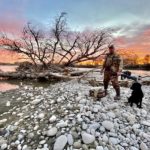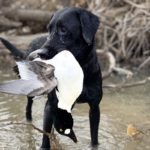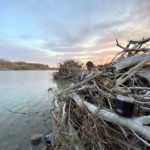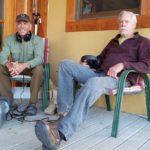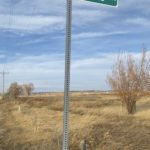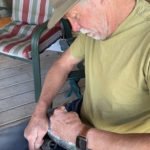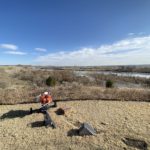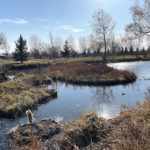While watching Canada geese trading along the Yellowstone River from his Montana back porch, innovator Bruce Kania tells Ramsey Russell about “the business of inventing.” Influenced by a grandmother that taught him to snare rabbits, he grew up archery hunting in Wisconsin, became a young muskie guide, and eventually moved to Montana to chase elk. His Biohaven Floating Island technology is distributed worldwide, cleans water, increases fishery productivity and is even a scalable solution for water quality problems in the Chesapeake Bay, the Gulf of Mexico and world oceans. The invention was inspired while duck hunting in what he refers to as the Red Dog Story. A close encounter with a mountain lion is also recalled. What are some of his other inventions and what key advice does Kania have for would-be inventors? How did duck hunting inspire this technology? Besides floating duck blinds, what are some of the ways the biohaven floating islands are being used worldwide? And if he uses this technology to form his own country, will there be ducks? Some great inventions have originated in the duck blind, but this one takes it to whole ‘nuther level.
Related links:
Bruce Kania’s Floating Islands International is a Practical, Scalable Solution for Improving Water Quality Worldwide, Was Invented While Duck Hunting in Montana
Our primary direction since 2005 when we launched commercially has been water quality enhancement. We work in stormwater ponds or wastewater settings or natural fish ponds. What we’re finding, Ramsey, is that the islands are a way to launch nature’s food web and to grow the preferred lifeforms that we ultimately all desire. – Bruce Kania, Inventor, BioHaven Floating Islands
Ramsey Russell: Welcome back to Duck Season Somewhere. I am in Montana 15 – 20 minutes east of Billings sitting in a cabin overlooking the beautiful Yellowstone River where we duck hunted this morning. What a real treat. Today’s guest is Bruce Kania, [who] runs a company called Floating Island International. Very interesting subject. How are you today, Bruce?
Bruce Kania: [I’m] doing great, Ramsey. How about you?
Ramsey Russell: If I were any better I’d still be sitting in the duck blind. That was a lot of fun this morning.
Bruce Kania: You sure started off early: 45 minutes before legal, just to get waiting out there towards the main channel.
Ramsey Russell: Well, for a flatlander to wade down that goat trail to the river itself and then across those slippery rocks, we got set up a little bit after legal, and we didn’t have too much. We took a half dozen goose decoys and three or four duck floaters, but it worked out beautifully. I would say this morning at sunrise may have been one of the most beautiful mornings of duck hunting I’ve ever experienced. It was just something about being on that Yellowstone River this morning that was beautiful, absolutely gorgeous. Bruce, what’s your story? Where are you originally from and how did this start?
Born and Raised Hunting in Wisconsin
We came onto a pond and there was a duck that became my launch into the duck hunting world, shooting at it with bows and arrows and ultimately collecting a small blue-winged teal as I recall.
Bruce Kania: I was born and raised in Wisconsin. In fact, the place called Marinette County, up north of Green Bay, was my home base. In fact, I went to college at the University of Wisconsin-Madison. While doing that, I had a fun job, actually. I started a recreation tabloid. I enjoyed writing about hunting and fishing, and that’s what it was about.
Ramsey Russell: [Have] you ever heard of a guy named Aldo Leopold?
Bruce Kania: Yeah, actually. [He’s] sort of an icon when it comes to the environment.
Ramsey Russell: The father of wildlife management came from the university that you went to. Did you grow up duck hunting out in Wisconsin? I know you’re an avid hunter now. Tell us about growing up in Wisconsin.
Bruce Kania: I have five brothers, no sisters. An unusual family makeup, but three of the brothers, including me, enjoyed hunting and were certainly passionate about getting out any possible way we could. We had a neighbor who I ran into at one point, I think I might have been 9 or 10, but he was shooting a bow, and of course I was totally intrigued. With his guidance, over time, ultimately I developed around bow hunting, especially. Along the way, my grandmother taught me how to snare rabbits with that multi-stranded, picture-hanging ware. I’d have a paper route and run my snare line at the same time. There were times I would come back with almost as much weight in rabbits as I had with newspapers at the beginning of the route.
Ramsey Russell: I wonder where she learned to do that. Maybe the depression era, just survival.
Bruce Kania: She and her family had been raised up in Phillips, which is Northern Wisconsin and lumber mills, I recall. That’s really wild country that’s up there towards Flambeau Flowage and some of the remarkable musky water that happens in Northern Wisconsin.
Ramsey Russell: Were you a big musky fisherman?
Bruce Kania: Yeah, as I was running that recreation tabloid, it was a wonderful opportunity to advertise myself as a musky guide.
Ramsey Russell: Oh really?
Bruce Kania: You were telling some stories about your son a while ago and his entrepreneurial spirit. We have some of that going on, but certainly not at the level your son seems to have taken it.
Ramsey Russell: Obviously, he’s talking about the Duncanator who sold bobcat feet and turtles and everything else in high school. When you talk about the rabbits and the archery, what about the waterfowl? Was there a lot of waterfowl out there?
First Duck Hunt
Bruce Kania: I remember, in fact, that gentleman that taught me how to hunt had a German short hair and we were bow hunting in the neighborhood. You get along a railroad track, for example, and hunt the cover to either side of the track and look for pheasant and rabbit and whatever we could find. But, at one point, we came onto a pond and there was a duck that became my launch into the duck hunting world, shooting at it with bows and arrows and ultimately collecting a small blue-winged teal as I recall.
Ramsey Russell: Wow, a blue-winged teal with archery. When I was a little boy, I’d go out and try to shoot robins, which I have since learned was illegal, with a stick and string. I was about one for 100 arrows slung at them. To hit a duck on the water is something else. How did you get your arrows back?
Bruce Kania: Yeah, even with massive flu-flu arrows. I remember once doing a duck and pheasant hunt [at] my brother’s operation. He was running a dog kennel and they had a neighboring farm that grew waterfowl and pheasant. For this particular time, we were interested in developing a hunting video around archery for ducks and pheasants. Boy, look what’s coming over us right now, Ramsey.
Ramsey Russell: Guys, what he’s talking about is we’re sitting here overlooking Yellowstone River and there’s about 100-150 big Canada geese flying over.
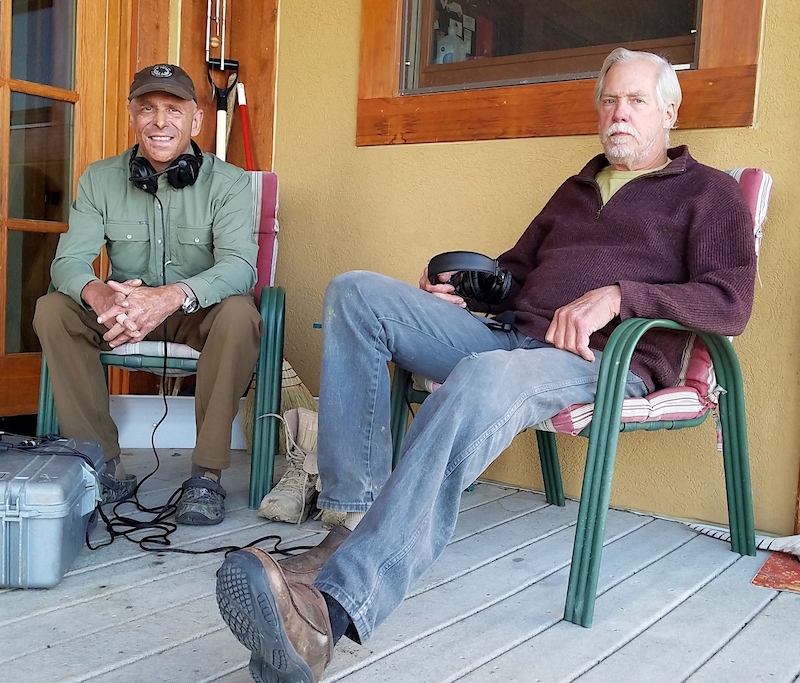
Bruce Kania: It’s a bit of a bluebird day and they’re flying high, but there will be times over the course of the winter when we get them coming over the bluff here 50 yards up. A reasonable range relative to old side by side, 10-gauge one-and-three-quarter-ounce rounds, triple B’s.
Ramsey Russell: Do you hand load those or no?
Bruce Kania: No, I don’t. I’m able to find them.
Ramsey Russell: Well, you were telling me this morning as we were out there hunting and we waited on these birds to come back. They sat out in the field all day apparently. But we did have one single come by [around] 70-80 yards. I said, “Why didn’t you shoot him?” Now I know why you didn’t shoot him. Yeah, now I get it. We didn’t raise your guns. We just watched them fly over. Where were we?
Bruce Kania: About the initial duck hunting.
Ramsey Russell: That’s right. The initial duck hunting.
Bruce Kania: One time that my brother and I took off for Lacrosse and we hunted opener on the Mississippi River. It was just an amazing experience. Legal began at noon at that point in time and about a quarter to 12 all of a sudden “boom-boom-boom-boom-boom.” By 5 to 12, there was no break in the shooting, so many ducks happening. Any game warden could have probably done really well in that setting. But I swear you could hold your arm out and watch the BBs ounce off.
Muskie Fishing in Wisconsin
To have a client come to you and he’s literally muscle-bound, massive shoulders, and he gets out there and he’s throwing one of them 2-pound baits for a couple of thousand casts while I’m guiding them. You can appreciate where those muscles come from.
Ramsey Russell: I heard that. That must have been something that we’ve all been there back when we were little boys. I was in Wisconsin not too long ago with a friend and he started talking about musky fishing. Is that like a pike? You don’t have that fish down South.
Bruce Kania: Yeah, [it’s] the musky and the muskellunge or the tiger musky, which is a hybrid between musky and pike. They are incredible fish. We talked about that Florida strain largemouth bass that gets really cagy and hard to catch. Well, I’ve seen settings where literally you could bomb 45-50 inch musky, you could see from the boat, the water clarity was such that you could actually see that fish out there. You could throw everything in the world on top of him and by him. Maybe at some point, it might be the 45th time, he gets irritated and slashes at that big old bobby-baiter.
Ramsey Russell: He’s trying to get rid of who is annoying him.
Bruce Kania: 2-pound Suick, those are some of the old, classic lures we used to throw at them. To have a client come to you and he’s literally muscle-bound, massive shoulders, and he gets out there and he’s throwing one of them 2-pound baits for a couple of thousand casts while I’m guiding them. You can appreciate where those muscles come from.
Ramsey Russell: That’s a big trophy at the end. It’s not sport fishing in terms of making the grease hot. The guy’s just there to catch those just big tiger musky trophies. Is that right?
Bruce Kania: Yeah. In fact, as I recall, they had to be over 30 inches just to keep them.
Ramsey Russell: My goodness. Are there any out here in Montana?
Bruce Kania: Yeah, we have a couple planted in different lakes across the state. We have some lakes that hold musky, but not many.
Videoing Hunts Precursor to Becoming an Inventor
We call this huntography. One of our stories is that you can identify a huntographer because one of his arms is longer than the other.
Ramsey Russell: During lunch, you were telling me about [how] y’all had gotten into wanting to film some and we had talked about this previously before those geese flew over. You talked about wanting to do some filming and I thought that was pretty incredible how you invented back then and had this camera set up.
Bruce Kania: This would have been the second half of the 80s. I was just getting into the business of invention. I certainly [was] very in love with archery, both tournament archery and shooting. I’d shoot a compound bow, but without pins. One idea developed at that time. There was a floating plate device that we built and threaded into the riser of a compound bow. You could slap an 8mm camcorder on top of that. The floating plate system would keep you from blowing up the camcorder. Back then, you were getting about 30 frames per second. It might be the same yet, I don’t know. When you hit the tape run button, it takes a few seconds to engage, and then when you shoot you can actually see four, five, or six frames of footage tracking the arrow flight.
Ramsey Russell: Really?
Bruce Kania: You’d want big puffy flu-flues to help the camera find the arrow and be able to see it because you’re just looking at the back end of the arrow with the camera’s perspective.
Ramsey Russell: What date are we looking at? When, on a timeline, are we looking at you having invented this system?
Bruce Kania: ’86, ’87, right in there.
Ramsey Russell: Cameras weren’t the size of an iPhone back then or even these tiny little palm-helds. As I remember back in the 80s, they were big, looked like a big old tape recorder or something. I mean these were big cameras, Bruce.
Bruce Kania: We developed a name for this, we call this huntography. One of our stories is that you can identify a huntographer because one of his arms is longer than the other.
Ramsey Russell: Yeah, from carrying that. Tell us about your shooting at pheasant at that time coming down the line, because your wife was telling me earlier today as we were out here before lunch. She was talking about the timing on ducks versus pheasants. Sometimes she’s not dialed in for the other and she’s been having trouble with pheasants. After lunch you were talking about shooting with a bow and arrow back then.
Bruce Kania: Again, we’re really promoting the sales for this huntography mount.
Ramsey Russell: Sure.
Bruce Kania: We wanted to do an action-packed video. My brother has the place with the ducks and the pheasants. At one point, we’re doing a skirmish line through some cover when a rooster gets up on the far end and we’ve got arrows [flying]. The bird was doing fine literally 15 or 18 feet. in front of my camera. I’m holding out, I’m at full draw, when an arrow comes from the side, a bird arrow with loops on it. It hits the rooster, it’s a cloud of feathers, but the bird powers through it, it keeps going now. Now, he’s 20 yards out. Look, Ramsey.
Ramsey Russell: Oh! Right there, more geese guys.
Bruce Kania: That lower flight there. Those are shootable with that 10-gauge system.
Ramsey Russell: I believe so.
Bruce Kania: Anyway, I get a final shot on the bird to connect, so actually two hits on a pheasant, arrow in flight. We got video footage of it too. I think we called that video “Huntography Profile Number One.” I went on and went commercial with it many, many years ago, though.
Ramsey Russell: Did y’all do well with it?
Bruce Kania: I sold it to a gentleman. [Actually,] I licensed it to a gentleman and that kind of launched me into the business model of licensing inventions instead of doing the hard work of production.
Ramsey Russell: That seems like the smartest way to do inventions.
Bruce Kania: If you want to live in Montana, anyway, because we’re not really an industrial center, we’re not close to the big volume markets or any of that. But I sure do dearly love living here.
Ramsey Russell: I can see why. Your view is to die for. You got this skeet machine jumping out over the river and geese flying back and forth while we’re recording in this beautiful view. I can see why you like Montana.
Bruce Kania: There’s another story with that camcorder system. I’m up elk hunting at one point. It’s late September, in that dark timber up north of the White Sulphur Springs area and the little belts. I’ve been up well before dawn, and here I am in this nice cool shady area and there’s a patch of sunlight up against the tree and I thought, “I’m going to lay down and take a nap.” I’d been calf-calling, cow-calling on my way in, and I just stank of elk, that wonderfully umami smell of elk and the rut. Five minutes later, though, I’m not falling asleep. You know how you can be tired at times, but just don’t fall asleep. I got bored and then got up and I’m brushing myself off when, about 12 feet away, is a mountain lion. It had been sneaking up on what it thought was a calf elk.
Ramsey Russell: You?
Bruce Kania: Me. I get up and I don’t look like a calf elk. I’ve got this contraption in my hand, the bow and arrow, and the camcorder in front of it. I hit the tape run button, and in this deathly silent spot you could hear a whisper, the buzz of ‘wrrrr’ of the eight millimeter camcorder. Anyway, I hit that and it takes about three seconds to engage. I wanted to capture the event of whatever happened.
Ramsey Russell: “These are my last moments.”
Bruce Kania: That cat was huge and it had a totally white face. I’m guessing it was a very, very old animal, but it spun and ran before the three second period. I kept the camcorder pointed on the animal as it was running through the timber, but I didn’t get a single frame of footage. That’s how fast the cat was.
Ramsey Russell: And how slow the cameras were back then.
Bruce Kania: That too.
Ramsey Russell: Maybe that’s what woke you up. Maybe your sixth sense went off and you just realized that. That’s perfect timing that you wake up when the mountain lion is fixing to have lunch. How did you end up, because you were out here elk hunting, out here from Wisconsin?
Bruce Kania: I was in a relationship at the time and my wife was eager to try something different. I’ve been running a recreation tabloid back in Wisconsin while going to college and right after college. Ultimately, my wife wanted to move West and that brought us to Billings, Montana. We lived in Bozeman for a couple of decades, and now I’m back here in Shepherd, Montana in the Yellowstone.
Ramsey Russell: Did you ever guide or anything when you moved out here and do any work in wildlife?
Bruce Kania: Yeah, in fact, when living in Bozeman, I was guiding bowhunters up in that country and especially in the Madison Valley area. I had some favorite ground to hunt up in that country, near a cowboy heaven. That would be a place [called] Avid Elk Hunters, a name they’ll recognize.
Becoming an Inventor before Floating Islands International
Persistence: staying with it, keeping on nudging it, prodding it, moving along. The prototype process is energizing. You can track your ability to get commercial, to get to the point where you’ve got something that people are going to want to buy.
Ramsey Russell: If I had come out here to this region when I was young I would’ve stayed. I would’ve gotten used to the winters and there’s no way I would’ve left and gone home. You mentioned earlier today, Bruce, about the business of inventing, and we talked about the huntography. We’re going to talk about one of the other products. But what other inventions have you had? Is that how you define [yourself]? Are you an inventor?
Bruce Kania: That’s how I’ve made my living over the years. Ultimately, I’ve got a prosthetic leg on my left side below the knee, and it doesn’t limit me now, like it did back then. That truly motivated me, back in the 80s again, to work on figuring out a way to enjoy the remarkably soft material that was being used at the time for bicycle seats, some form of a thermoplastic gel. Ultimately, one of my best inventions, in terms of return on investment and cash flow, was a liner for the residual limb of an amputee. You could put this on and make walking and running and everything else possible again because it would dampen the shock associated with walking on a prosthetic device.
Ramsey Russell: I can see that. I’m going to talk to you a little bit later after the podcast about something similar to that, but a lot of people come up with great ideas. I think of them all the time, [and] I didn’t intend to ask you these questions when we started the podcast, but I’m now wondering, what’s the difference [between] someone like yourself and someone listening, or someone like me, that has an idea and that actually does something with it? What would you say would be the difference in taking not just an idea, Bruce, but several ideas you’ve taken to full success?
Bruce Kania: I think that probably one word that explains most of it, and that would be persistence: staying with it, keeping on nudging it, prodding it, moving along. The prototype process is energizing. You can track your ability to get commercial, to get to the point where you’ve got something that people are going to want to buy. In fact, my main business now as an inventor is the Floating Island business. I project that we built some 400 prototypes before we got to what we went commercial with. When I hear people look at our product, the Biohaven Floating Island, and say, “Hey, I can do that at home.” If they’re talking with me, I’ll suggest to him that it may take a few prototypes to get to the same place. It’s the nature of invention. It makes sense. Products evolve and they’re supposed to.
BioHaven Floating Islands
Over the course of those 400 prototypes we were ultimately trying to biomimic nature’s wetland effect. Nature’s wetland effect, that combination of surface area, which is what our filter material, which is what we make the islands out of, provides. You combine that with circulation and aeration, and you just essentially replicated how nature does it in terms of cycling nutrients into healthy forms of life.
Ramsey Russell: That’s right, that’s exactly right. Nothing stays static. It’s always an evolution of progression and getting better and more improved and more efficient. Let me backup for just a second because I’ve known you and Ann for a while. It was quite a while ago, I’d say it was 10 years ago, y’all called and we got to know each other, and y’all went to New Zealand on an extended hunting trip and shot ducks and geese, and I think she has some family there. I remember your email was “Floating Islands.” You had an email very similar to that denoted, and I’m like, “What the heck are floating islands?” How did you come up with this idea? I know it had something to do with a red dog.
The Red Dog Story Lead to Floating Islands Concept
That experience motivated me to learn and understand and invent around the water quality. I didn’t even have a word for it back then.
Bruce Kania: Yeah, the red dog story. Actually the dog was black. His name is Rufus. Here is Rufus, he was two years old. The dog had charisma. He’s one of those dogs that people come over here to see Bruce, but I think they really came over to connect with Rufus, an awesome pup. I had purchased this particular farm, a few 100 acres, and immediately put a pond in because I wanted to invent and work around water and agriculture, where they connect with the interface. I put this pond in using ditch water from a local irrigation ditch. Late that summer, Rufus is out there swimming in his pond and he comes back to the shore, shakes himself off, and within a few minutes his black dog hair takes on a reddish hue.
Ramsey Russell: Oh!
Bruce Kania: I swear you could smell him from 50ft upwind. I had friends at Montana State University, people that work there at the Center for Biofilm Engineering. I went to them for help to understand what’s going on here. We live in Montana, we’re a headwater state. Water should be wonderfully clean and pristine. The nutrients associated with that farm water, that irrigation water, given the right conditions, explode in the harmful algae blooms. We’re seeing so much of that around the world right now. The cyanobacteria is associated with that harmful algae, it’s a form of it. It was what was producing that remarkable stench.
Ramsey Russell: That’s where the red dog came from because he became red. It’s not only color, but it was odorous.
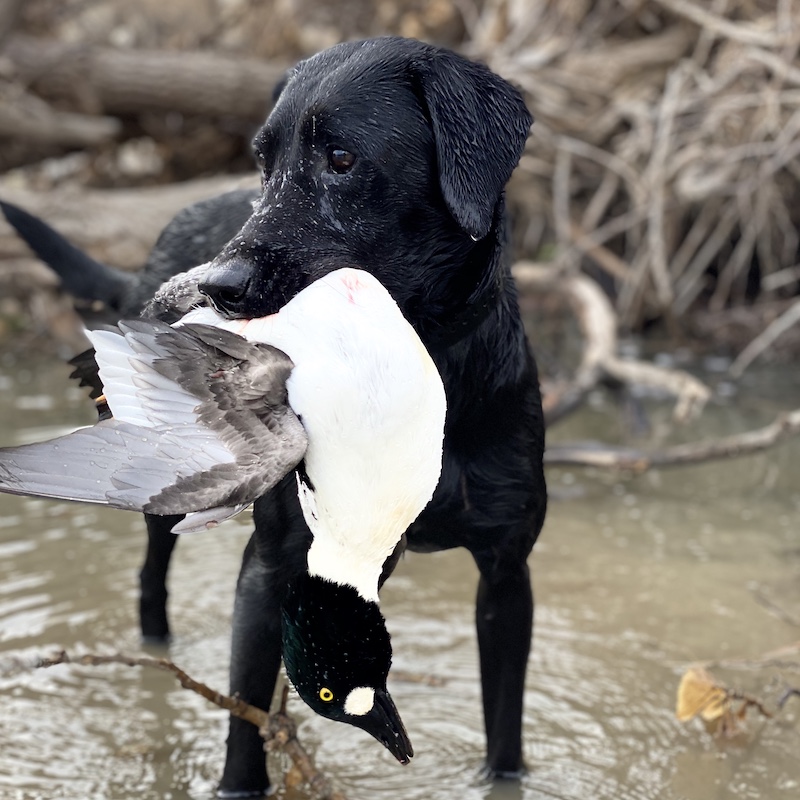
Bruce Kania: Absolutely.
Ramsey Russell: Wow. That had to do with, I’m guessing, a lot of nutrient overload, runoff coming in from agriculture, some of their fertilizer and stuff like that was driving this system towards that.
Bruce Kania: In fact, that experience motivated me to learn and understand and invent around the water quality. I didn’t even have a word for it back then. Now we do. The breakthrough was when I started thinking about where I used to go to experience the very best water. Places like Chippewa Flowage in Northern Wisconsin, home of the world record musky. Also home to many dozens of huge, naturally occurring floating islands, including a 130 acre island that I’ve hired Ex Special Forces Master Divers to get underneath in the dangerous diving conditions to understand those islands and how they were in their makeup. We would record them.
I remember one time we were there and we thought “Let’s interview every fishing boat we come to today on this 18,000 acre reservoir.” We ultimately came up on 11 different boats, 9 of which were fishing the perimeter of these floating islands. Why? When you snorkel or dive along the perimeter, it becomes really obvious. Why? It’s like a floating fish factory. The nutrients in Chippewa Flowage are being cycled into and through these massive filters, these naturally occurring floating islands, and those nutrients are transitioning into a form. The technical term is diatom-based paraffin. Those nutrients cycle into this material that’s an alternative to cyanobacteria, an alternative to blue green algae, and it grows fish. The real home run is this: if you’ve got water that is impaired, too many nutrients, and today is growing algae, you have the ability to take those same nutrients and grow fish with them instead. The keyword to do that is stewardship, [with] biomimicry nature as a model.
Ramsey Russell: Wow. Where did you go? You’re thinking about this Chippewa Flowage and these natural floating islands that somehow formed and took a life of their own and so you came up with your idea to mimic it and build one. I know looking at your slides it’s a floating islands duck blind but it could be a boat dock, it could be something but far more sophisticated. You were showing me some of the substrate you use, but it floats. But it’s more than a floating dock or a boat blind, it’s way more than that because you’ve got this substrate and you’ve got this system that begins to take a life of its own.
Bruce Kania: You’re absolutely right. Over the course of those 400 prototypes we were ultimately trying to biomimic nature’s wetland effect. Nature’s wetland effect, that combination of surface area, which is what our filter material, which is what we make the floating islands out of, provides. You combine that with circulation and aeration, and you just essentially replicated how nature does it in terms of cycling nutrients into healthy forms of life.
How BioHaven Floating Islands Improve Water Quality
Ramsey Russell: Where did you come up with that synthetic filter material that you use for floating islands? That’s incredible. You said something to me, Bruce, as I was walking around looking for a walking stick so that I don’t slip. I said, “I bet the bottom of that river is slippery.” You go, “Oh yeah, it’s slippery.” You use the scientific name that’s a foot long, but basically it means slippery. How does that all play into this?
Bruce Kania: The very base of the food web and fresh water is going to be a plant [life] form [or] a plant-based lifeform, phytoplankton. There’s going to be what’s called the heterotrophic lifeform, and that would be biofilm generating microbes. Microbes and their residue, what’s left over when they die, forms biofilm, and biofilm is the base material for that long word you were talking about, paraffin.
Ramsey Russell: Okay.
Bruce Kania: Now, when you do that, when you grow paraffin, you’re essentially growing an alternative to harmful algae blooms.
A Scalable Water Quality Solution: BioHaven Floating Islands In Use Worldwide
Because of their size and scale, floating islands ultimately represent a way to fix the harmful algae bloom potential connected with these large bodies of water. There really isn’t any other scalable solution. All of a sudden we’re hitting on a scalable solution. Something that could even go after places like Chesapeake Bay, Lake Erie, the Gulf of Mexico.
Ramsey Russell: I got you. You went through 400 prototypes. Y’all came up with this model of a floating island. Then what? What do you use it for, besides a duck blind? I know there’s a lot of uses and a lot of countries now that are embracing your technology.
Bruce Kania: As of now, we’re at over 9,000 Biohaven floating islands launched around the world. We’ve got half a dozen manufacturers building them, each of which has their own territory. My company, Floating Islands International, is a master distributor, so we market to the rest of the world. Some of the applications: there is a really exciting one unfolding right now in which floating photovoltaics, floating solar, is happening. We can support solar panels on Biohaven floating islands. Beyond that, we also have a wonderful application out there. We can dampen wave action with this system so we can protect the floating solar systems. Let’s imagine you’re on a large hydro power reservoir setting, and there’s plenty of fetch and high winds. I can truly influence the lifespan of that solar array.
I envision Biohaven floating islands being the protective perimeter for such systems and, because of their size and scale, this ultimately represents a way to fix the harmful algae bloom potential connected with these large bodies of water. There really isn’t any other scalable solution. All of a sudden we’re hitting on a scalable solution. Something that could even go after places like Chesapeake Bay, Lake Erie, the Gulf of Mexico. We’ve been through a handful of direct hits by hurricanes already, and the product is resilient. We’re surviving. We went through a typhoon in Singapore at one point as well, [and] a tornado right here. What else? Oh yeah, a massive windstorm in Oregon where the winds got up to 160 miles an hour, [which] went on for a day and a half. I remember a 48-inch snow dump at a place called Elfin Cove, outside of Juneau Alaska. We had floating islands there. On the bottom of the floating islands, you’ve got this three or four inch crust of barnacles that vector with this setting. They just love that filter material to latch onto and on top of the island, 48 inches. But because the biofilm being created within the matrix is in and of itself buoyant, the system’s buoyancy was just fine.
Ramsey Russell: That’s crazy. Well, over lunch, you had also talked about [how] there was one you built for somebody that had some unbelievable amount of gravel for an endangered species nesting habitat.
Bruce Kania: Yeah, it was a large habitat project for the US government, the Army Corps of Engineers. 40,000 square-foot supporting 900 tons of gravel as habitat for the Caspian Tern.
Ramsey Russell: That’s just unbelievable.
Bruce Kania: Here’s the other thing that we’re learning, Ramsey, that were we’re kind of scratching their heads about. When you launch floating islands in one measurement, 11 weeks later, we do a dry weight on the island, putting it in the water, then we take it out, and we put a core known volume, and we get it down to dry weight again and we discover that we’ve grown by some 72% in dry weight mass, so it weighs almost double what it weighed initially.
Ramsey Russell: Why?
Bruce Kania: Because we’re essentially learning how to grow humus. We’re learning how to grow real estate.
Ramsey Russell: What does it do for water quality and fish production?
Bruce Kania: Our primary direction since 2005 when we launched commercially has been water quality enhancement. We work in stormwater ponds or wastewater settings or natural fish ponds. What we’re finding, Ramsey, is that the floating islands are a way to launch nature’s food web and to grow the preferred lifeforms that we ultimately all desire. We’ve got wonderful, dramatic even, examples of islands as fish aggregating devices. You saw, in fact, on some of the slides, the incredible concentration of fish under the islands. We had 10 kids who were raising money for their school. They got a whole bunch of sponsors. One kid had 14 sponsors and they’re all paying them a dollar for every fish he caught. Well, those 10 kids came out here on a Saturday morning in September, just a couple of years back, [and] they caught 634 fish in 4.5 hours.
Ramsey Russell: Yeah, that was a nice little fundraiser and a heck of a fish fry, I’m thinking.
Bruce Kania: They raised some $10,000.
Ramsey Russell: Wow. Did you tell me that Mississippi State University had actually done some research on fish productivity subsequent to these floating islands being deployed?
Bruce Kania: Yeah. We had a PhD student working on his thesis under Dr. Wes Neil. They took a floating stream bed embodiment of floating island and in a nicely scientific, controlled, independent, third-party setting, learned that the system with the island in it generated 19% more fish biomass than the other systems.
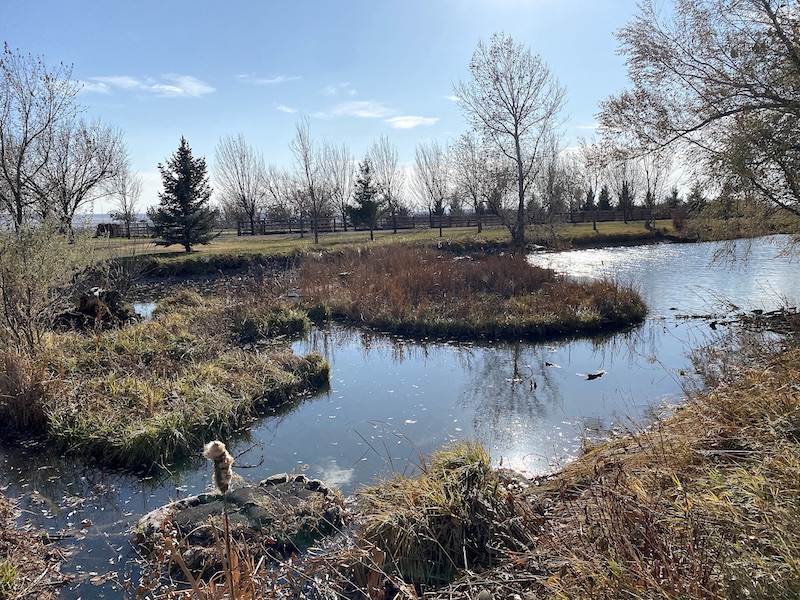
Ramsey Russell: That’s unbelievable.
Bruce Kania: Excuse me, than the control.
Ramsey Russell: I knew what you meant. I’m thinking about a US Congressman or somebody talking about an island flipping over and I didn’t want to sound like this guy but this did occur to me as I was looking at your films. Have you ever had a light-seated tree species become rooted in some of these substrates? I can just imagine a willow tree or cottonwood even taking root and getting so tall. Will they grow?
Bruce Kania: It’s hard to find a plant that we can’t propagate on the islands, but we bias towards native woody fibrous perennials: again, nature’s model. However, there is a new science unfolding now around hyperaccumulator plants that can actually take up more than a proportionate amount of nutrients that occurred in conventional lifeforms. There is another form of hyperaccumulator, though, that’s even more effective than plants, and that is fish. I will give you an example: you need some 1,100 pounds of filamentous algae to make up, let’s call it, a wet basis. I don’t know how else to describe it, but this algae has been piled up and stacked and allowed to drain overnight. You need 1100 pounds of that to pull out 1 pound of phosphorus. On the other hand, it only takes 105 pounds of northern yellow perch. The yellow perch is a hyperaccumulator. Here on Fish Fry Lake, I don’t know if you recall the photos of a perch, but the biggest one we’ve weighed now is 1 pound and 11 ounces. Just the other day I caught one that was probably about that weight, and just incredibly fat and chunky, the size of the massive perch we used to catch on Lake Michigan, growing up in the ’60s.
Using BioHaven Floating Islands to Fix Global Crises
I’m really impatient to see these systems that can fix the huge waterways, the salt and seas of the world, the Gulf of Mexico with its dead zone. I read in one article that there’s some 390 other dead zones in marine settings. If they’re happening, you go up watershed from them, you’re going to find thousands and thousands of lakes that are impaired, that are experiencing this nutrient pollution, that ultimately causes them to run out of dissolved oxygen and not be able to sustain any kind of a healthy food web.
Ramsey Russell: My goodness. Where do you see this technology going in the future? Like you were saying earlier about products continuing to evolve and become better and more efficient, where do you see this moving forward?
Bruce Kania: I have this dream of owning my own country.
Ramsey Russell: Yeah, build it.
Bruce Kania: 201 miles offshore. It’s a dream, and ultimately I do think that latching onto the floating photovoltaic market will be our window to really large projects that can pay for themselves. A term for that is called the water resource recovery. The idea of recovering value from the space on top of a reservoir by generating solar power but concurrently, as a byproduct, fixing the water, preventing the HABs. Think about drinking water reservoirs, they can get shut down when the harmful algae bloom occurs.
Ramsey Russell: I’ve heard about some of these big dead zones out of the Gulf out in the ocean, some of these problems, I’ve even heard about like these mass islands of plastic particles. There’s four major ones out in the oceans in the Gulf Streams. Do you see this kind of floating islands technology as potentially being a cure for either of those or both of those?
Bruce Kania: Thank you for that question. It’s something that we have focused on for the last six or seven years now but the tiny micro particles of plastic which make up the bulk of the plastics and the gyres that you’re describing, they’re a form of total suspended solids, the technical term is TSS. We have worked up a design, we call it the floating stream bed, [with which we] can lift water vertically and horizontally into and through a floating island. That TSS bonds to the sticky biofilm so it’s a way to harvest it and use that TSS to ultimately become captured within the core of the island, and contribute to its ultimate size and scale.
Ramsey Russell: It’s entirely possible, because you could do this floating island technology, and, like you said, it’s scalable enough now that humanity can tackle these problems using technology similar to what you’ve developed.
Bruce Kania: Ramsey, it’s such a hopeful place to be, really energizing. I’m really impatient to see these systems that can fix the huge waterways, the salt and seas of the world, the Gulf of Mexico with its dead zone. I read in one article that there’s some 390 other dead zones in marine settings. If they’re happening, you go up watershed from them, you’re going to find thousands and thousands of lakes that are impaired, that are experiencing this nutrient pollution, that ultimately causes them to run out of dissolved oxygen and not be able to sustain any kind of a healthy food web.
Ramsey Russell: It’s got to be fixed. It’s got to be addressed sooner or later. This isn’t just a duck hole in the Delta. This is a global issue right here. It’s only getting worse, Bruce, as you well know. Folks, you’ve been listening to Bruce Kania, Floating Islands International. His link is on the description. I’ll tell you, the people you meet while you’re out running around goose and duck hunting, huh? We’re [about] to go shoot some pheasants here in just a little bit. Bruce, thank you very much for coming on today. I have one last question I just thought of: when you do build your own floating islands country, 200 miles offshore, will it be big enough to have some ducks and geese?
Bruce Kania: Yeah and I’ll mention something curious, but freshwater is buoyant, it floats on top of seawater. Not only will we have some waterfowl habitat, but we’ll have habitat appropriate for both marine and freshwater forms of waterfowl.
Ramsey Russell: Sign me up. It’s Duck Season Somewhere, as we always say. I want to come visit you.
Bruce Kania: We get to designate our own season.
Ramsey Russell: International boundaries.
Bruce Kania: Yep.
Ramsey Russell: It’ll be your country.
Bruce Kania: There you go.
Ramsey Russell: Oh, yeah, sign me up. I’m coming. Folks, thank you all for listening to Duck Season Somewhere. We’ll see you next time.




